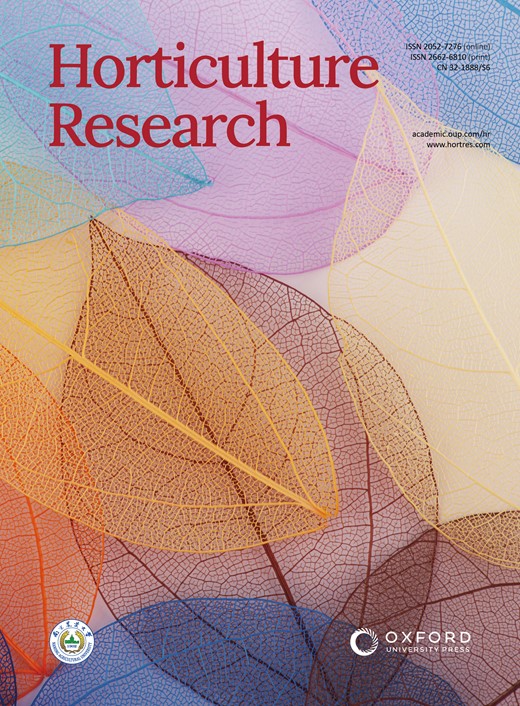Accumulation of dually-targeted StGPT1 in chloroplasts mediated by StRFP1, an E3 ubiquitin ligase, enhances plant immunity
IF 8.7
1区 农林科学
Q1 Agricultural and Biological Sciences
引用次数: 0
Abstract
Chloroplasts play a crucial role in essential processes such as photosynthesis and the synthesis of primary and diverse secondary metabolites. Recent studies have also highlighted their significance linked to phytohormone production in plant immunity, especially SA and JA. Ubiquitination, a key post-translational modification, usually leads to target protein degradation, which acts as a signal for remodeling the proteome via the induction of protein endocytosis or targeting to other membrane associated systems. Previously, the potato E3 ligase StRFP1 was shown to enhance resistance against Phytophthora infestans, but its mechanism remained unclear. Here, we demonstrate that StRFP1 interacted with the dually localized plastid glucose 6-phosphate transporter StGPT1 on the endoplasmic reticulum (ER). Transient expressed StGPT1-GFP located on the chloroplast and ER in plant cells. Overexpression of StGPT1 enhances late blight resistance in potato and Nicotiana benthamiana, activates immune responses including ROS bursts and up-regulation of PTI marker genes. The resistance function of StGPT1 seems to be related to its dual localization. Remarkably, StRFP1 ubiquitinates StGPT1 at the ER, possibly due to its merely transient function in peroxisomes, leading to apparent accumulation in chloroplasts. Our findings point to a novel mechanism by which a plant E3 ligase contributes to immunity via interacting with dually-targeted GPT1 at the ER of plant cells.由 E3 泛素连接酶 StRFP1 介导的叶绿体中双靶标 StGPT1 的积累可增强植物免疫力
叶绿体在光合作用、初级和多种次级代谢产物的合成等基本过程中发挥着至关重要的作用。最近的研究还强调了叶绿体在植物免疫中与植物激素(尤其是 SA 和 JA)的产生有关的重要性。泛素化是一种关键的翻译后修饰,通常会导致目标蛋白质降解,并通过诱导蛋白质内吞或靶向其他膜相关系统,作为重塑蛋白质组的信号。在此之前,马铃薯 E3 连接酶 StRFP1 被证明能增强对 Phytophthora infestans 的抗性,但其机制仍不清楚。在这里,我们证明 StRFP1 与内质网(ER)上双定位的质粒葡萄糖 6-磷酸转运体 StGPT1 相互作用。瞬时表达的 StGPT1-GFP 位于植物细胞的叶绿体和 ER 上。过表达 StGPT1 可增强马铃薯和烟草的晚疫病抗性,激活免疫反应,包括 ROS 爆发和 PTI 标记基因的上调。StGPT1 的抗性功能似乎与其双重定位有关。值得注意的是,StRFP1 可在 ER 中泛素化 StGPT1,这可能是由于它在过氧物酶体中仅具有短暂的功能,导致其在叶绿体中明显积累。我们的研究结果指出了一种新的机制,即植物 E3 连接酶通过与植物细胞ER中双重定位的 GPT1 相互作用来促进免疫。
本文章由计算机程序翻译,如有差异,请以英文原文为准。
求助全文
约1分钟内获得全文
求助全文
来源期刊

Horticulture Research
Biochemistry, Genetics and Molecular Biology-Biochemistry
CiteScore
11.20
自引率
6.90%
发文量
367
审稿时长
20 weeks
期刊介绍:
Horticulture Research, an open access journal affiliated with Nanjing Agricultural University, has achieved the prestigious ranking of number one in the Horticulture category of the Journal Citation Reports ™ from Clarivate, 2022. As a leading publication in the field, the journal is dedicated to disseminating original research articles, comprehensive reviews, insightful perspectives, thought-provoking comments, and valuable correspondence articles and letters to the editor. Its scope encompasses all vital aspects of horticultural plants and disciplines, such as biotechnology, breeding, cellular and molecular biology, evolution, genetics, inter-species interactions, physiology, and the origination and domestication of crops.
 求助内容:
求助内容: 应助结果提醒方式:
应助结果提醒方式:


